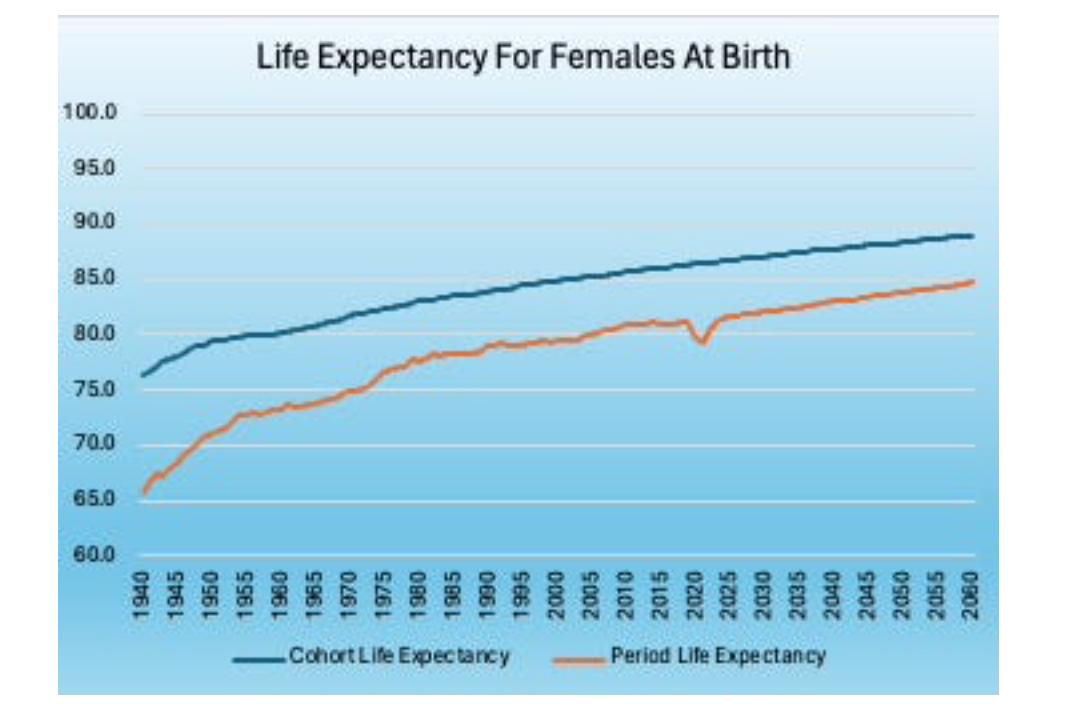Written by: Eugene Steuerle
What You Read About Life Expectancy Is Quite Misleading

Source: Social Security Single Year Tables V.A4 & VA5
With the COVID-19 onslaught, stories have abounded about a decline in life expectancy for the population as a whole. Recent headlines note a modest improvement in 2023 but that we still haven’t fully recovered to 2020 levels.
The headlines, if not the reports themselves, are downright misleading. Life expectancy, as commonly defined, likely did not decline during the COVID-19 pandemic nor even in some recent years when mortality rates spiked due to drug use, obesity, and what is sometimes labeled as “deaths of despair.” Don’t get me wrong: these health issues are quite serious and must be addressed. However, though no one knows the future for certain, any conclusion that life expectancy has declined relative to those born in earlier years almost certainly is wrong.
Let me explain. While the details can get a bit wonkish, the main thing you need to know is that the banner headlines depend upon a particular measure called “period life expectancy” that does not apply to any actual person. It is a measure in each year of a hypothetically constructed person whose mortality at any future age replicates precisely the average mortality rate at every age in that single past year. For instance, period life expectancy calculated for newborns in 2020 assumes that when turning 65 in the year 2085 they die at the same rate as 65-year-olds in 2020, in the midst of the COVID-19 crisis. Ditto for every other age. When they reach age 5, 35, or 75 in 2025, 2055, and 2095, the likelihood of those 2020 newborns dying would be the same as those aged 5, 35, and 75 in 2020.
For that calculation to hold true, all future gains in health care, such as improved cancer treatments, would need to be offset by further declines somewhere else. I know of no demographer anywhere who believes that to be true.
In fact, with some quirky exceptions, almost all projections of life expectancy show that a person born in one year will have a higher life expectancy than someone born the previous year. For instance, someone born in 1955 (and would be 65 in 2020) can expect the same or more months of life than someone born in 1954, and someone born in 1956 more months than someone born in 1955.
Unfortunately, the media and some policy advocates migrate to using period life expectancy because “if it bleeds (or bleeds more), it leads,” making it easier to talk about how our society faces decline or to justify some pre-determined policy conclusion such as that Social Security reform should be delayed.
When almost everyone talks about life expectancy, they refer to what technically is called cohort life expectancy. Cohort life expectancy involves projections for how many years, on average, real people likely will survive, based upon research as to past trends and causes of death. For instance, when Social Security actuaries predict how many years of benefit payments you will receive, they take into account how improvements in health will add to your years of life, as well as the temporary effects of aberrations like COVID-19. Thus, they predict that a female born in 2023, on average, would live to age 86.6 under cohort life expectancy, but only 81.2 under period life expectancy.
Blips can occur in both period and cohort life expectancy but are much more likely in the former, which reflects mortality in one year, whereas the latter reflects mortality in all remaining years. Note in the above graph on life expectancy for females born in every year from 1940 to 2040, the Social Security actuaries predict a very temporary downward blip in period life expectancy but not cohort life expectancy.
Period life expectancy does serve useful purposes. Its hypothetically constructed persons in any year up to the present reflect only what has actually happened. One would expect, for instance, that population-wide average mortality in 2020 was higher than in 2019 because of COVID-19. Cohort life expectancy, on the other hand, requires projections into the future for anyone alive today. For someone aged 70 today, for instance, it uses data on actual life expectancy from birth to age 69, but thereafter must make projections that are clearly less precise. Period life expectancy, therefore, allows one to highlight declines or increases in actual mortality rates from one year to the next and help make the projections of cohort life expectancy.
Bottom line: reports on life expectancy should begin with what people think of as life expectancy. Period life expectancy reflects population-wide mortality rates for given years, but not remaining longevity for real people. In my view, it probably should not even be called “life expectancy,” at least without qualifying adjectives, given the confusion it causes.
Related: For the Good of the Country, Older Americans Should Work More and Take Less

